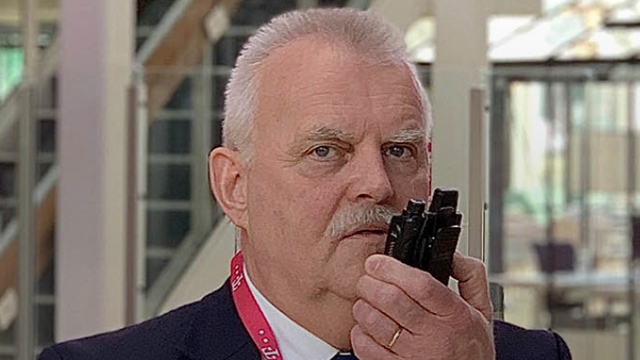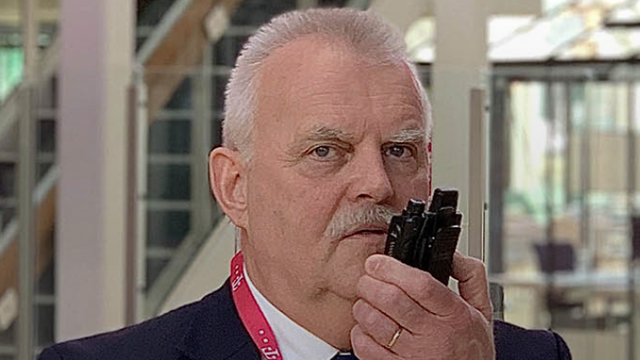
News
In the spotlights: Mission-critical communication via 4G/5G

This month we are not putting a profession in the spotlight, but our connectivity partner T-Mobile. T-Mobile explains how (broadband) Push-To-Talk helps improve mission-critical communications.
For years, not many options were available for mission-critical communications. Previously, companies, security guards, and law enforcement officers relied on one-to-one telephony, or walkie-talkies. At the national level, there are TETRA systems that can only handle voice (e.g., C2000). With the advent of mission-critical group communications (Push-To-Talk), fully integrated into T-Mobile’s reliable network, these long-standing options still appear to have many limitations. Mission-critical communication is in need of a big improvement: in addition to voice, data as well. You can read how that works in this article.
Working in crisis situations requires sharp and clear communication. Security officers (industry, events), FAFS officers, fire department, police, ambulance and other emergency services need a lot of information from each other and need to understand each other well. At the moment the national emergency services still use TETRA for this purpose. This is a national communication system exclusively for emergency services. But in the absence of a secure alternative, the sharing of certain information (such as photos and data) is still often done via mobile public internet communication. The deployment of Push-to-Talk over mobile broadband on a smaller scale (in the security and emergency services of companies, events or by Boa’s in cities) shows that something much better is available.
Push-to-Talk has it all
Push-to-Talk (PTT) from PrioCom is a communication solution (app) that uses 4G/5G and is fully integrated into the network. No use is made of the (public) internet, but through a private, protected part of the T-Mobile network. This achieves maximum security. It has national coverage, works via smart walkie-talkies (Android/iOS smartphones) and is full of smart features that allow you to communicate easily and efficiently, and not just by voice. Whereas with walkie-talkies you are often stuck with a limited network with limited range, with Push-to-Talk these restrictions all fall away. A call can be sent from any location, all over the country and directed to a specific group of emergency workers. This way, only the services that are really needed, in the area where the problem occurs, get the call. Especially the use of dynamic groups and the use of “chat” functions make a difference in this.
How Push-to-Talk works in practice
Suppose there is a riot between activists on the square in a big city. The dispatcher in the police control room can then quickly create a dynamic group of police officers who are or will be in the vicinity of the square. Simply by drawing a circle on a digital map and selecting the Boa’s that are walking around there or will be coming to it later. Only these Boa’s receive the message on their smart walkie-talkies and can communicate about it together in their dynamic group. In this way, they can communicate quickly and efficiently with each other and with the control room. For example, about the deployment of other emergency services.
Because speech is no longer the only (and not always the most efficient) way to communicate, the system also has a “chat” functionality. Here text, image or video can be shared. An ideal opportunity to get an even better picture of the situation for all concerned.
An additional benefit are the reports that the new service can offer. Think of reports on the conversations conducted, emergency calls and signals. But also about the deployment of people, their location history and messages: everything can be played back afterwards. The solution also offers additional security options for employees working alone.
Broadband communication is the future
With this much broader set of possibilities in communication, the dispatcher suddenly gets much more tools to do her job well. A specific group of emergency workers can be deployed for a crisis situation, and it is easy to establish contact with dispatchers and users of other crisis services. This greatly improves the cooperation and efficiency of crisis services. But it also works the other way around. The smart walkie-talkie is equipped with one button that gives you direct contact with the control room: the emergency button. The dispatcher can then immediately help and thanks to GPS see where the reporter is located.
One of the many satisfied users
PTT is already widely used: think of (de)central government, business, but also in various hospitals, industry and the events sector. Of course T-Mobile’s security and emergency response teams also use PTT from PrioCom. This is supplied through their business partner Flash Private Mobile Networks. Dennis de Bruin, Manager Security Operations at T-Mobile, has been working with the system since the beginning of 2021 and is more than satisfied: “It really is an improvement compared to the radios we had before, especially the national coverage is very handy. Not only to keep in touch with different locations, but also because I can now simply listen in from home and help out in the event of an emergency.” From the headquarters in The Hague, switchboard operators oversee four main T-Mobile locations, in addition to the main office. Does a fire alarm go off somewhere or does an office need to be evacuated? Be it in one of our retail stores or at a corporate event elsewhere in the country? If so, the use of the same PTT system can make this happen much more safely and efficiently.

Strategic partnership
Couldn’t T-Mobile have developed this service itself? Richard Marijs, Network Strategist at T-Mobile, explains: “T-Mobile actually believes in combining strength, knowledge and experience. Instead of developing it in-house. We choose to develop this critical (group) communication with network priority with partner PrioCom. We provide our best tested mobile network, and they provide the technology behind this special service. PrioCom is a party that has the right knowledge and experience and can continue to focus on the further development of this type of service for this market in the long term.” Nico Hortensius, Business Development Manager at Priocom is also very clear about this: “We consciously choose for a strategic partnership between three parties. T-Mobile offers us a reliable network with data priority (PrioCom is specialized provider on the network of T-Mobile), we monitor the performance and development of the Push-to-Talk application and our business partners take care of customer specific services (sales, implementation, support). With this focus, we can jointly provide the PrioCom end users with the best quality. And a business partner like Flash Private Mobile Networks is indispensable in this. Franklin Brandse, account manager at Flash: “With our knowledge, experience and passion for mission critical communication we make organisations safer and more efficient. With a critical attitude, we always look for the question behind the question. That’s how we arrive at the best advice.”
Next step in mission-critical communications
The limited operation of walkie-talkies and TETRA systems are really no longer imaginable in this digital age. It is clear that mission- and business-critical communication can now do much better. Fortunately, the PTT service of PrioCom, has partnered with T-Mobile to save the day. Flash is marketing PrioCom’s Push-to-Talk service as SmartCom.
